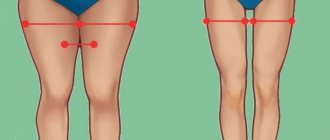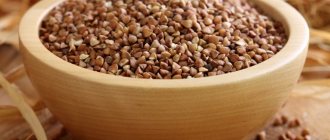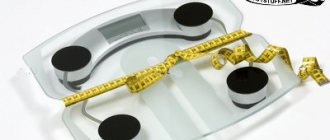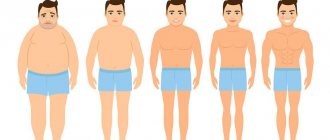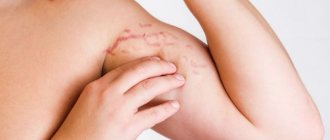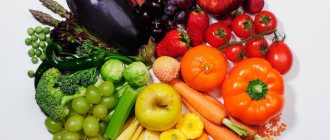January 14, 2011
How is nutrition structured for weight loss in case of obesity, what food should you give up, and what should be left for normal functioning of the body.
It is necessary to fight excess weight. It not only makes a person unattractive, but is a serious risk factor for the development of a huge number of diseases. Including such poorly treatable and potentially fatal ones as heart attack with stroke or even cancerous tumors. However, even if you are truly overweight, the choice of diet for weight loss must be taken very responsibly. The common belief that in order to lose excess weight it is enough to eat almost nothing for a while or even go hungry is a misconception. After all, the goal is not only to lose weight, but also not to harm your health.
How is a diet designed for obesity?
Overweight or obese?
Obesity is usually diagnosed with a body mass index (BMI) of 30 or more. You can find out your BMI yourself using our calculator. And what other formulas there are for determining a healthy weight are described in a special material.
Many diets have been developed for the treatment of obesity, but the main principle of traditional diet therapy is a sharp reduction in calorie intake, proportional to excess of normal body weight. This indicator is calculated individually for each nutritionist’s client, but usually with severe excess weight, the number of calories is reduced by an average of 40 percent of the daily energy requirement.
Basic principles for losing weight:
1. Reducing the calorie content
of the diet to 1800 kcal and below, calculated by a specialist based on the person’s initial weight.
2. Limiting fast carbohydrates in the menu - especially sugar and white flour products (pasta, pastries, white bread) - the main suppliers of energy
that are easily stored in fat.
3. Limit animal fats
by 50 percent.
But this does not mean that the diet becomes fat-free. Animal fats in the diet are replaced by vegetable fats, which can activate the process of the body using up its own fat reserves. 4. Creating a feeling of satiety
by increasing the proportion of low-calorie but high-volume foods in the diet - raw vegetables, fruits, whole grain products.
5. Small meals - up to six times a day
- help fight hunger.
The daily ration is simply divided into six equal parts, which are eaten at regular intervals. 6. Refusal of
foods that stimulate the appetite - spices, herbs, savory snacks, smoked meats and pickles.
7. Limiting the amount of salt to five g per day and normalizing the drinking regime
- up to 1.5 liters per day, mainly clean drinking water.
IF Protocol (Intermittent Fasting)
Intermittent Fasting
is a popular nutrition trend with a scientific evidence base. Today, intermittent fasting is considered one of the leading patterns of life extension. The purpose of this nutritional system is to create a gap between meals, which allows the body to rest from the digestion process. The brain does not receive fast fuel and switches to reserve sources - the pancreas begins to produce the powerful hormone glucagon. Glucagon is able to convert glucose from protein (amino acids), while simultaneously stimulating the processing of fats to provide energy for vital processes.
Microbiologist Christian De Duve noted the appearance of new organelles (lysosomes) in liver cells under the influence of this hormone. These structures can convert cellular waste into energy, cleansing the cell and prolonging its life.
There are several variations of intermittent fasting:
- Demo version (12/12 or 10/14) is a habitual diet that excludes a heavy dinner.
- Active user (8/16), where the main period without food occurs at night. This system is popular in the fitness industry.
- The advanced level (24/0) requires preparation, proper “exit” and the absence of contraindications.
- The warrior diet (20/4), in which meals are eaten within a four-hour interval. The diet is based on an active lifestyle that does not involve large meals throughout the day. However, light snacks of fresh vegetables and nuts, unsweetened tea, and water are acceptable.
- Method 5:2. According to this system, food consumption without restrictions is allowed for 5 days, then for 2 days the diet is reduced to 25%. The average caloric intake during this period should be no more than 500-600 kcal per day.
Therapeutic diet
When treating obesity, nutritionists usually use diet No. 8
, the calorie content of which they can increase or decrease by eliminating certain foods in the diet.
| Products | It is forbidden | Can |
| Bread | White, all baked goods | Black, protein - up to 150 g per day |
| Soups | Meat, fish and mushroom, all strong broths | Soups based on vegetable broths, weak broths made from lean meat |
| Meat | Pork, goose, duck, lamb, fatty chickens, all smoked meats and sausages | Lean beef, rabbit, fat-free chicken, boiled or stewed |
| Fish | All fatty varieties, smoked or fried | Low-fat boiled or steamed fish, seafood |
| Vegetables | Potatoes, beets, carrots and other vegetables with a high glycemic index | Cabbage, leafy vegetables, radishes, cucumbers, tomatoes, greens - raw or baked, seaweed |
| Cereals, legumes, pasta | Pasta | Cereals, beans or lentils as sources of essential amino acids - instead of bread. |
| Egg dishes | Fried omelettes or fried eggs | Boiled, steamed |
| Dairy | Hard cheeses, margarine, sour cream, full-fat milk and cream | Low-fat milk, kefir, yogurt, cottage cheese |
| Fruits | Sweet fruits with a high glycemic index | Sour and sweet and sour varieties of fruits and berries up to 200 g per day |
| Beverages | Compotes, jellies and nectars with sugar, sweet soda, sweet juices | Coffee or tea without milk and sugar, juices from sour fruits and berries, mineral water |
| Fats | Lard, margarine, spreads | Butter and vegetable oils - 20 g per day only for cooking |
The essence of medical diets
Many diseases worsen precisely because of poor nutrition. For example, if a patient with diabetes breaks his diet, his blood sugar level rapidly rises above normal, he is constantly thirsty, feels dry in his mouth, and fats accumulate in the cells of the liver and pancreas. Chronic pancreatitis makes itself felt with excessive consumption of fried, fatty foods (for example, pancakes, sour cream), as well as alcohol. If you have hypertension, you cannot eat a lot of salty foods, otherwise your blood pressure will rise above normal, and even treatment will not correct the situation.
It was already mentioned above that the types of diets in medicine (in hospitals, sanatoriums, dispensaries and other institutions of a similar type) differ in numbers. In addition to numbers from 1 to 15, there are also variations, such as N 1a, 16, N 7a, 7b, 7c, 7d.
Even if the patient’s exacerbation has passed, it is not recommended to go far from the principles of the type of dietary table prescribed to him. You still cannot eat prohibited foods, but you are allowed, for example, to eat something home-canned or use different processing methods. That is, simmer or, after boiling, bake.
And in order to get the daily requirement of vitamins, you can additionally drink rosehip decoction, eat wheat bran, or buy it at the pharmacy and take Hexavit, Decamevit, Gentavit, and other vitamin complexes.
No matter what type of diet we are talking about, alcohol is prohibited in any case. There are rare exceptions, but you still can’t do it without consulting your doctor.
If one patient is diagnosed with two diseases, each of which has its own diet, then a diet is prepared taking into account the requirements of each of the prescribed diets. For example, the type of diet for diabetes is table No. 1, but if the ulcer has worsened, then foods that are prohibited if it is present are removed from the menu.
Or here’s another example of the type of diet for diabetes - table No. 9. It provides six meals a day in the form of first and second breakfast, lunch, dinner, afternoon snack and a snack before bed. It is recommended to boil and bake food, but fried and stewed foods are sometimes allowed.
List of products allowed for consumption:
- Eat about 300 g of bread and other flour products per day. The bread should be rye, protein-bran, protein-wheat. If it is purely wheat, then it is made from second grade flour.
- Weak broths made from meat (low-fat varieties), fish, mushrooms with the addition of vegetables and cereals (only those that are not prohibited), potatoes, maybe with meatballs. Any vegetable first courses (borscht, okroshka, cabbage soup, etc.).
- Meat - lean, boiled (pork tenderloin, beef, veal, lamb, chicken, rabbit, turkey). In very small quantities - tongue, liver, dietary varieties of sausages.
- Fish - only low-fat. You can have canned fish, but only those in tomato or in its own juice.
- Milk, fermented milk products, low-fat cottage cheese, cheese (lightly salted, with low fat content). Sour cream - in very small quantities.
- Eggs - soft-boiled, no more than 1-1.5 eggs per day. An omelet is made from only whites.
- Legumes. Cereals - in the form of porridges (oatmeal, millet, buckwheat, barley, pearl barley).
- Vegetables (can be raw): pumpkin, cabbage, eggplant, zucchini, cucumbers, tomatoes, lettuce. In small quantities: potatoes, carrots, beets, green peas.
- Any sweet and sour fruits and berries - fresh or in the form of jellies, compotes and other dishes. Candies and cookies only contain sorbitol, xylitol or saccharin instead of sugar. Honey - just a little bit.
- Sauces - only low-fat ones, prepared in weak meat, fish, mushroom or vegetable broth. Pepper, mustard, horseradish - in very small quantities.
- Ghee and butter (unsalted) are allowed as fats. Vegetable - little by little, as part of dishes.
- Drinks include tea, coffee with milk, rosehip infusion, juices (any vegetable, and fruit and berry juices - only those that are not very sweet).
Contraindicated foods for this type of diet are rich or puff pastries, pastries, cakes, fatty fish or meat (pork, duck, goose) or broth made from them. You cannot eat smoked products (sausages or others), caviar, salty foods (fish, cheeses), curd cheeses, cream. Rice and semolina are excluded (including in the form of milk soup). Pasta is acceptable, but in very small quantities. Pickles and marinades, sweet fruits and dried fruits (dates, raisins, figs, bananas, grapes) are prohibited. Juices from sweet fruits, ice cream, candies, jam, alcohol, soda and cooking fats are prohibited.
The doctor decides how much sugar a patient can consume per day based on the prescribed dose of insulin.
What to remember
Treatment of obesity involves a low-calorie diet combined with exercise.
Despite the fact that when losing weight you have to give up many foods, your diet must contain a sufficient amount of protein, fat and foods containing a lot of fiber. For individual recommendations, it is best to contact a nutritionist. Tags:
- Diets
- Diet
- Overweight
- Weight loss
- Therapeutic diets
• To leave a comment you must be an authorized user
- Usavel Fitness Sweets are the most popular variety of healthy probiotic candies. The most useful of all types. There are 2 types: with goji berries and with blueberries. In addition to the indisputable fact that these berries are extremely beneficial for the whole body, fitness fruits are also created to strengthen the immune system and prevent dysbacteriosis, and also contain stevioside, which is the most useful of all sugar substitutes. Suitable for adults: dietary food (does not contain sugar and fat), diabetic nutrition, sports nutrition (has a restorative effect when playing sports). If you are interested in our products, then you can find out more on the website: biosynergy[dot]ru or call by phone (calls within the Russian Federation are free)
- Usavel Immunofets are no less useful probiotic candies for immunity and the prevention of dysbiosis; in addition, they contain fructose, which is sweeter than sugar, but does not have the harmful effects of sugar. There are seven types: strawberry, raspberry, blueberry, blackcurrant, cherry, lime and milk flavor. Suitable for children and adults who have restrictions on sugar intake, and those who are on various diets and dream of sweets.
- Usavel In our opinion, the best solution is a combination of sweets and healthy supplements. Children and adults, when eating candy, additionally receive beneficial bifidobacteria and lactobacilli, as well as microelements to increase the body's immunity. We present to you a line of healthy food products - “Biofet”, “Immunofet”, “Fitnessfet” containing probiotics and extracts of delicious and healthy berries and fruits. Biofets are healthy probiotic candies that strengthen the immune system and are also used to prevent dysbacteriosis. The product line includes three types: banana, blueberry and milk flavor. Suitable for children and adults who want to strengthen their immunity and not think about dysbiosis while consuming delicious sweets.
- Usavel Healthy candies for the whole family! How often do you remember to eat healthy? We all think about eating healthy, but don't stick to it because it may not taste as good as other less healthy foods that fill grocery store shelves. Parents often think that they should feed their children healthy food to avoid health problems in the future. After all, we all know about the dangers of food that we buy for the joy of children. But the whole problem lies in the small range of products, high cost and poor taste.
- kurashko I have been on many diets, but the most optimal ones, where the weight really goes away, are the fermented milk diet, the Mayo Clinic diet... and count calories... the most important thing is to drink vitamins
- efremenko Eat less and most importantly exercise.
AIP protocol (autoimmune)
AIP (autoimmune protocol)
aims to reduce inflammation, pain and other unpleasant symptoms that people experience with autoimmune diseases. This effect is achieved by eliminating potentially aggressive foods from the diet and building the food axis to relieve increased intestinal permeability. This protocol consists of two phases: an elimination phase and a reintroduction phase.
The elimination phase vetoes foods and medications that may cause intestinal inflammation. After all, the inflammatory process directly affects our immunity.
At this stage you should completely remove:
- alcohol, tobacco,
- refined and processed sugars,
- nutritional supplements,
- nightshade vegetables (tomatoes, eggplants, bell peppers),
- dairy products,
- legumes, nuts, seeds.
During the reintroduction phase, previously eliminated foods are gradually reintroduced into the diet to identify potential antigen foods.
This protocol is necessarily accompanied by an improvement in life factors. It is necessary to improve sleep, monitor physical activity, and work through stressful situations. The first results with this style of nutrition are noticeable after three weeks. The average duration is one to three months. Important emphasis of this protocol is the balance of the microbiome and the absence of stress factors. For nutritional support, I would recommend the following medications:
- Multidophilus from Solgar. The content of polysaccharides in it provides nutrition to our microbiome, and a complex of beneficial bifidobacteria and lactobacilli, 5 billion probiotic microorganisms in 1 capsule will help maintain the balance of beneficial microflora.
- 5NTR from NOW FOOD not only helps normalize sleep, but also increases serotonin levels, allowing us to reduce the aggressive impact of external factors on our nervous system. The composition of this drug is enriched with vitamins C and B6, as well as important auxiliary components and amino acids such as glycine, niacin, taurine, inositol in synergy, enhancing the effect of the main component.
- "Motherwort Forte" is a unique drug from the Evalar company. It has a quick calming effect, helping to improve the emotional state. The basis of the dietary supplement is an extract of motherwort, which grows in Altai. This particular strain has one of the highest rates of sedation.
5-HTP, 50 mg, 90 capsules, NOW
1 590 ₽
Dietary supplement NOT A MEDICINE
Motherwort Forte with magnesium and B6, 40 tablets, Evalar
219 ₽
Dietary supplement NOT A MEDICINE


